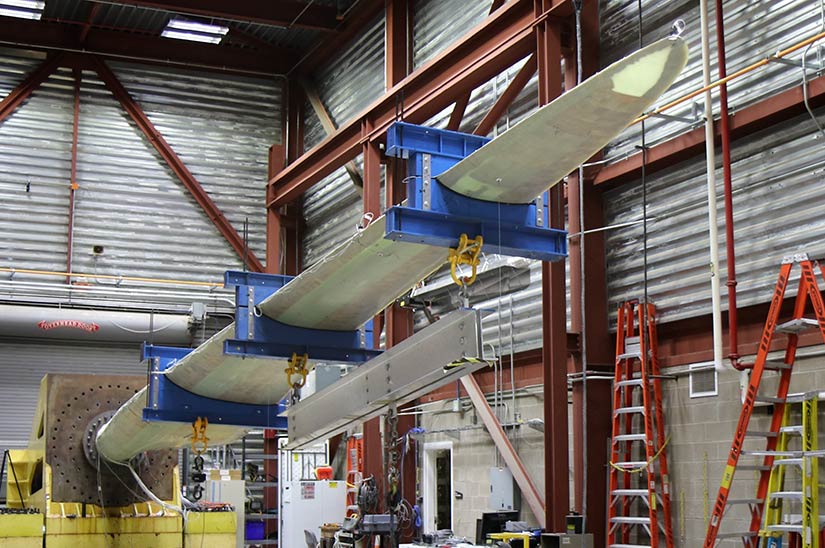Structural Research Facilities
NLR's structural research facilities enable the characterization and validation of kilowatt- to multimegawatt-scale wind turbine blades and components.
NLR helps industry partners verify and improve new component designs, analyze structural properties, and improve manufacturing processes. Our Flatirons Campus is home to state-of-the-art equipment and data acquisition systems that are capable of validating blades and components smaller than 1 m to more than 50 m in length. In addition, modal, acoustic emission, thermography, and surface characterization systems are available to our partners.

Component and Complete-Blade Validation
The primary types of rotor blade research performed at NLR include:
- Inertial and modal characterization methods used to evaluate inherent structural properties, including mass-balance, natural frequencies, and mode shapes
- Static strength loading to validate design values and demonstrate the ability of a component or system to handle extreme loads applied by cranes, hydraulic actuators, or servo-electric winches at multiple stations along the blade
- Cyclic fatigue loading, which applies millions of cycles of accelerated fatigue loads to demonstrate the durability and lifetime of a blade or component. Our capabilities range from single-axis validation by direct-load application via servo-hydraulic actuators, up to biaxial loading by validating flapwise and lead-lag directions simultaneously using resonant research systems.
NLR's unique simulation capabilities allow for high-fidelity modeling and validation of turbine design and optimization.
Infrastructure and Hardware
Offering a combined 1,800 m2 of laboratory space, NLR's three structural research facilities share servo-hydraulic control and actuation equipment. Our laboratories include:
- Five reaction stands with overturning moment capacities from 100 kilonewton-meters to 16.7 meganewton-meters
- Modular servo-hydraulic systems with hydraulic flow capacity of 680 liters per minute
- Servo-hydraulic actuators with force capacities from 5 to 500 kilonewtons and actuator stroke capacities to 1.5 meters
- 100- and 500-kilonewton structural load frames
- Servo-electric winches for quasi-static load application.
For additional information about structural research validation, see the Structural Research fact sheet.
Data Acquisition and Results
NLR combines custom data acquisition software tailored for static strength and fatigue validation with a data acquisition system capable of recording hundreds of data channels. Our partners can access:
- Multichannel modal systems
- A 48-channel Physical Acoustics acoustic emission system
- API laser tracker for surface characterization and three-dimensional displacement measurements
- Micron Optics Fiber Bragg Grating fiber optic interrogator
- Flir thermal cameras for active and passive thermography
- Extensive inventory of load, displacement, and strain sensors
- Digital image correlation for full-field strain and displacement measurements.
Partner with Us
The Flatirons Campus's structural validation facilities include experimental laboratories, computer facilities for analytical work, tools and machine shops, office space for industry researchers, and space for assembling components and systems.
NLR offers a variety of ways for organizations to gain access to our wind technology expertise:
- Partner with us through technology partnership agreements.
- Participate in subcontracted wind research through solicitations and requests for proposals.
- Use our cutting-edge research facilities to develop and evaluate wind technologies.
Learn more about working with NLR.
Learn about NLR’s other wind energy facilities.
Share
Last Updated Dec. 6, 2025
